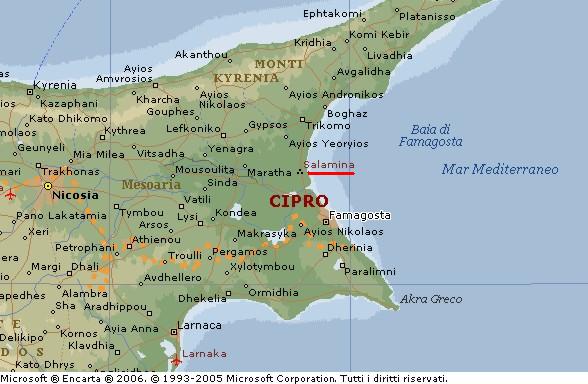Lessico
Sant'Epifanio
Vescovo di Salamina di Cipro
Padre della Chiesa (Besanduk
vicino a Eleuteropoli, Palestina, ca. 310 – 403 durante un viaggio in mare).
Condusse vita monastica in Egitto e nel 367 fu nominato vescovo di Salamina![]() (distrutta da un terremoto e ricostruita da Costanzo II
(distrutta da un terremoto e ricostruita da Costanzo II![]() ,
dal quale prese il nome di Constantia, Costanza), sulla baia di
Famagosta a Cipro. Fondò numerosi monasteri ed ebbe parte attiva nelle
controversie religiose del tempo. Fu a Roma nel 382. Influenzò fortemente San
Girolamo
,
dal quale prese il nome di Constantia, Costanza), sulla baia di
Famagosta a Cipro. Fondò numerosi monasteri ed ebbe parte attiva nelle
controversie religiose del tempo. Fu a Roma nel 382. Influenzò fortemente San
Girolamo![]() e nel 402 appoggiò il patriarca alessandrino Teofilo contro Giovanni
Crisostomo
e nel 402 appoggiò il patriarca alessandrino Teofilo contro Giovanni
Crisostomo![]() ,
tenendo sempre un atteggiamento ostile a Origene
,
tenendo sempre un atteggiamento ostile a Origene![]() .
La sua festa ricorre il 7 maggio.
.
La sua festa ricorre il 7 maggio.
Sue
opere principali: Ancoratus (374-377), trattato sulla fede
d'intonazione polemica, e Panarion (377), trattato contro le eresie. Il
Physiologus![]() ,
scritto in greco ad Alessandria d'Egitto tra il II e il III sec. dC,
nei secoli successivi fu attribuito a diversi Padri della Chiesa, specialmente
a Sant'Epifanio, San Basilio
,
scritto in greco ad Alessandria d'Egitto tra il II e il III sec. dC,
nei secoli successivi fu attribuito a diversi Padri della Chiesa, specialmente
a Sant'Epifanio, San Basilio![]() e San
Pietro di Alessandria (vescovo e martire, morto nel 311), oltre che a San
Giovanni Crisostomo, Sant'Atanasio di Alessandria (ca. 295-373), Sant'Ambrogio
e San
Pietro di Alessandria (vescovo e martire, morto nel 311), oltre che a San
Giovanni Crisostomo, Sant'Atanasio di Alessandria (ca. 295-373), Sant'Ambrogio![]() e San
Girolamo.
e San
Girolamo.
Gonzalo Ponce de León (nato in
Spagna intorno al 1530) nel 1588 grazie all'editore Christophe Plantin
pubblicava ad Anversa il commento di Sant'Epifanio al Physiologus (Sancti Patris
nostri Epiphanii, Episcopi Constantiae Cypri, ad Physiologum),
corredandolo di note esplicative. Proprio in questa edizione, alla voce De
Pelecano (Περὶ
τῆς Πελεκᾶνος – La Pellicana) troviamo il pellicano maschio che
resuscita col suo sangue i pargoli uccisi dai troppi baci della madre, il
quale è però raffigurato come avvoltoio (99,9% il capovaccaio, Neophron percnopterus![]() , dal collo impiumato), un'iconografia corrente, ma
aspramente criticata dallo stesso Gonzalo.
, dal collo impiumato), un'iconografia corrente, ma
aspramente criticata dallo stesso Gonzalo.
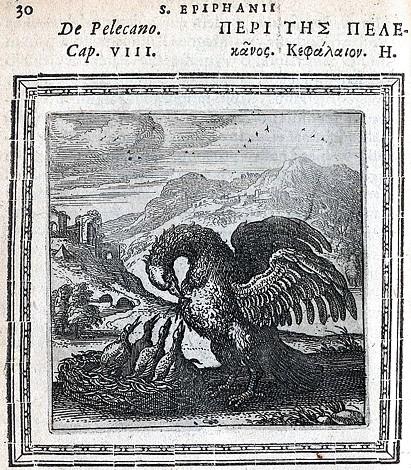
Commento
al Fisiologo di Sant'Epifanio
a cura di Gonzalo Ponce de León - Anversa 1588
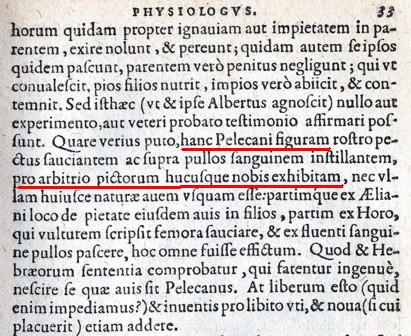
Salamina
di Cipro
- antica città dell'isola di Cipro, sulla baia di Famagosta, fondata, secondo
la leggenda, da Teucro, figlio di Talamone. Ciò sottintende la sua prima
colonizzazione greca sulla quale poi si sovrapposero immigrazioni d'altri
popoli, soprattutto egiziani e fenici. Nel sec. IV aC il re dell'isola,
Evagora, sottomise tutta l'isola. Nel 306 aC Demetrio I di Macedonia (ca.
336-283 aC), detto Poliorcete per l'abilità con cui assediò (peraltro
invano) Rodi fra il 305 e il 304 aC, sconfisse davanti a Salamina una flotta
egiziana. Nel 58 aC l'isola divenne romana e la capitale fu trasferita a Pafo.
Distrutta da un terremoto, la città fu ricostruita da Costanzo II![]() (317-361), e da lui prese il nome di Constantia, Costanza. Fu devastata
dagli Arabi nel sec. VII.
(317-361), e da lui prese il nome di Constantia, Costanza. Fu devastata
dagli Arabi nel sec. VII.
Sant'Epifanio
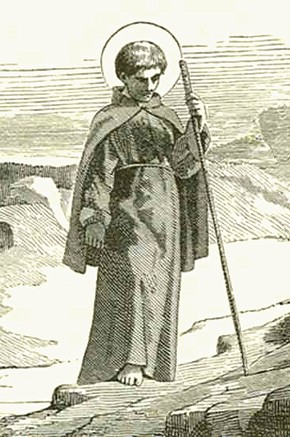
Epifanio (Besanduk vicino a Eleuteropoli, Palestina, ca.310 - 403 durante un viaggio in mare), santo, vescovo e padre della Chiesa. Nato in Palestina, trascorse in Egitto la giovinezza e, tornato in patria, fu ordinato sacerdote. Nel 335 fondò un monastero vicino a Eleuteropoli, che diresse per 30 anni. Nel 367 fu eletto vescovo di Costanza (antica Salamina), a Cipro, dove incoraggiò la crescita del monachesimo e combatté vigorosamente le eresie del tempo; in seguito, partecipò ai sinodi di Antiochia (376) e Roma (382). Tra i suoi lavori si ricordano Ancoratus (374-377), scritto polemico contro Origene e Panarion (377), un trattato sulle eresie. I suoi scritti sono una fonte molto importante per lo studio della storia della teologia. La sua festa ricorre il 7 maggio.
Epiphanius was born at Besanduk, near Eleutheropolis, in Judea, after 310; died in 403 in a sea travel. He entered the monastic life in Egypt while he was still very young. On his return to Judea he founded a monastery and was ordained to the priesthood. In 367 he was appointed Bishop of Constantia (Salamis) a city on the Island of Cyprus, where he remained for nearly forty years, though his activity extended far beyond his island. His zeal for the monastic life, ecclesiastical learning, and orthodoxy gave him extraordinary authority; hence the numerous occasions on which his advice was sought, and his intervention in important ecclesiastical affairs. He travelled to Antioch, Rome, and Constantinople to combat the various heresies. He was on one of these excursions when he died on his return journey to Cyprus.
Epiphanius produced many works. The earliest (374) is the "Ancoratus", or "The Well-Anchored", i.e. the Christian firmly fixed against the agitations of error. The author argues especially against the Arians and the Origenists. In the "Ancoratus" Epiphanius confines himself to a list of heresies. Some readers desired to have a detailed work on this question, and Epiphanius composed (374-7) the "Panarion" or "Medicine chest", i.e. a stock of remedies to offset the poisons of heresy. This work is divided into three books comprising in all seven volumes and treating eighty heresies. The "Panarion" furnishes very valuable information concerning the religious history of the fourth century, because the author confined himself to transcribing documents preserved by him alone or wrote down his personal observations.
In theological matters Epiphanius taught the doctrine of the Catholic theologians of his time. In the vocabulary of Trinitarian theology he conformed to the language of the Greek Church. With regard to the constitution of the Church, he was one of the most explicit of the Greek theologians concerning the primacy of St. Peter. Two passages on the Eucharist are famous because they are among those which most clearly affirm the "Discipline of the Secret". The "Secret" was purely pedagogical and often neglected, consisting in grading the doctrinal initiation of catechumens and in not speaking before them of the Christian mysteries save in deliberately vague expressions. Epiphanius is one of the chief authorities of the fourth century for the devotion to the Blessed Virgin. He expresses himself on the subject in connection with two heresies, of which one diminished, while the other exaggerated, this devotion. A circumstance of his life is well known in the history of images, namely the destruction of an image in the church of Bethel.
His character is most clearly shown by the Origenist controversies, which demonstrated his disinterested zeal but also his quickness to suspect heresy, a good faith which was easily taken advantage of by the intriguing, and an ardour of conviction which caused him to forget the rules of canon law and to commit real abuses of power. He saw in Origen the chief cause of the heresies of his time, and especially of Arianism. He did not confine himself to this condemnation of Origen. He reproached the monks and bishops of his time with accepting the Origenist errors. Thence resulted at the end of his life the conflict with John of Jerusalem and with St. John Chrysostom.
Much of the work ascribed to Epiphanius during the Middle Ages was probably not written by him. He almost certainly was not involved in the writing of the Greek Physiologus attributed to him by Consalus Ponce de Leon (born ca. 1530), though he may well have read it. This book, originally written in Greek at Alexandria, perhaps for purposes of instruction, appeared probably in the second century, though some place its date at the end of the third or in the fourth century. In later centuries it was ascribed to various celebrated Fathers, especially St. Epiphanius, St. Basil, St. Peter of Alexandria, John Chrysostom, Athanasius, Ambrose, and Jerome. All of the texts attributed to him were collected by J.-P. Migne in his Patrologia Cursus Completus, Series Graeca.
Adapted
in part from the Catholic Encyclopedia
http://gateway.uvic.ca/spcoll/physiologum/index.html
Epiphanius of Salamis
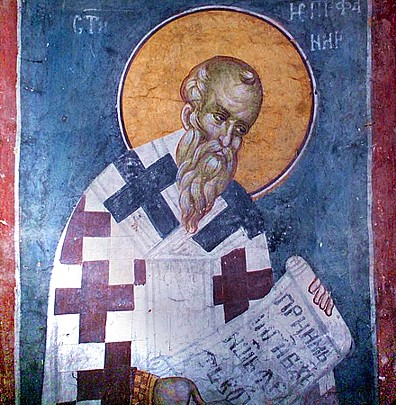
Icon
of St. Epiphanius
fresco at Gracanica monastery near Lipljan in Kosovo
Epiphanius (ca. 310–320 – 403) was bishop of Salamis and metropolitan of Cyprus at the end of the 4th century AD. He is considered a Church Father. He gained the reputation of a strong defender of orthodoxy. He is best known for composing a very large compendium of the heresies down to his own time, full of quotations from them.
Ecclesiastical life
He was born into a Christian family in the small settlement of Besanduk, near Eleutheropolis, Judaea, and lived as a monk in Egypt, where he was educated and came into contact with Valentinian groups. Returning to Judaea around 333, when still a young man, he founded a monastery at Ad nearby which is often mentioned in the polemics of Jerome with Rufinus and John, Bishop of Jerusalem. He was ordained a priest, and lived and studied as superior of the monastery for thirty years. He became versed in several languages including Hebrew, Syriac, Egyptian, Greek, and Latin and was called by Jerome on that account Pentaglossis ("Five tongued").
His reputation for learning prompted his nomination and consecration as Bishop of Salamis, Cyprus in 367. He was also the Metropolitan of the Church of Cyprus. He served as bishop for nearly forty years, as well as traveling widely to combat unorthodox beliefs. He was present at a synod in Antioch (376) where the Trinitarian questions were debated against the heresy of Apollinarianism. He upheld the position of Bishop Paulinus, who had the support of Rome, over that of Meletius of Antioch, who was supported by the Eastern Churches. In 382 he was present at the Council of Rome, again upholding the cause of Paulinus. During a visit to Palestine in 394 he attacked Origen's followers and urged the Bishop of Jerusalem to condemn his writings. Origen's writings were eventually condemned at the Fifth Ecumenical Council in 553. When Epiphanius was nearly 80, in 402, at the behest of Bishop Theophilus of Alexandria, the saint went to Constantinople to support Theophilus in his campaign against Saint John Chrysostom, and the four "Tall Brothers." When he realized he was being used as a tool by Theophilus against Saint John Chrysostom, who had given refuge to the monks persecuted by Theophilus and who were appealing to the emperor, Epiphanius started back to Salamis, only to die on the way home in 403.
Writings
His earliest known work is the Ancoratus ("the well anchored man"), which includes arguments against Arianism and the teachings of Origen. His best-known book is the Panarion which means "Medicine-chest" (also known as Adversus Haereses, "Against Heresies"), presented as a book of antidotes for those bitten by the serpent of heresy. Written between 374 and 377, it forms a handbook for dealing with the arguments of heretics. It lists 80 heresies, some of which are not described in any other surviving documents from the time. While Epiphanius often let his zeal come before facts - he admits on one occasion that he writes against the Origenists based only on hearsay (Panarion, Haeresis 71) - the Panarion is a valuable source of information on the Christian church of the fourth century. The Panarion was only recently (1987 and 1990) translated into English.
Aside from the polemics by which he is known, Epiphanius wrote a work of biblical antiquarianism, called, for one of its sections, On Measures and Weights. It was composed in Constantinople for a Persian priest, in 392. The first section discusses the canon of the Old Testament and its versions, the second of measures and weights, and the third, the geography of Palestine. The texts appear not to have been given a polish but consist of rough notes and sketches, his modern editor, Allen A. Shaw, concluded; nevertheless Epiphanius' work on metrology was important in the History of measurement. The collection of homilies traditionally ascribed to a "Saint Epiphanius, bishop" are dated in the late fifth or sixth century and are not connected with Epiphanius of Salamis by modern scholars.
